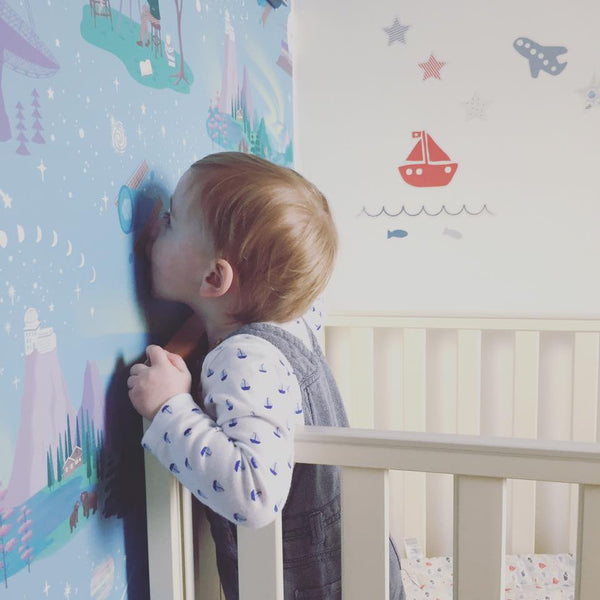As an eighties baby I fondly recall the bright, bold, fun illustrations that adorned products made for children; from puzzles and games to pyjamas, from wrapping paper to wallpaper. A lot of this design looks very much 'of it's time' now but I loved it then, as I imagine did so many others. The below 1980s paper demonstrates so well the imagination and attention to detail (the little mole's jumper-pun!) that struck a chord with children of that era.

In fact, one of the reasons I decided to design wallpaper for children's rooms was a discussion with a good friend in which she told me how much she adored her Brambly Hedge bedroom wallpaper as a child (Brambly Hedge is the beautiful creation of illustrator Jill Barklem, who's books about a community of industrious mice are still very popular today).
Wallpaper designed specifically for children became popular in Victorian Britain with the growth of the middle classes after the industrial revolution; an increasing number of families now had separate rooms for their children, and money with which to decorate those rooms. Designs were initially instructive in nature, intended to contribute to educational and moral development.
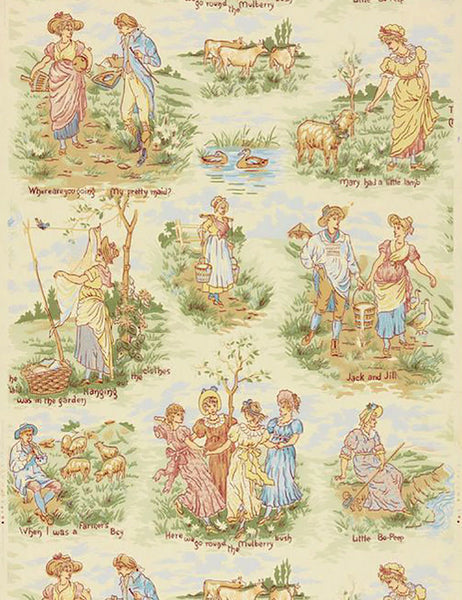
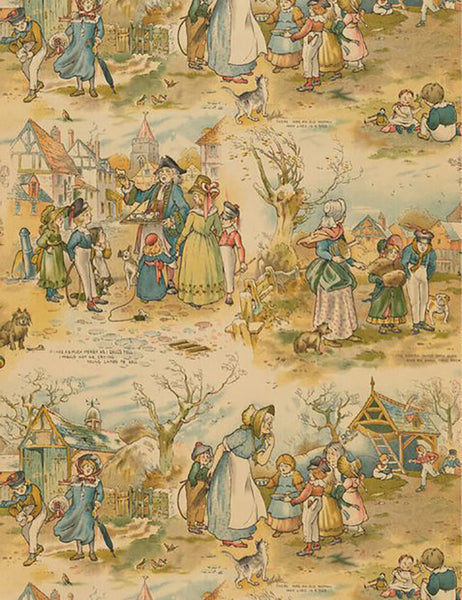

The three examples above come from the extensive online collection of Historic New England
The increasing popularity also ran alongside 'The Golden Age of Children's Book Illustration' (roughly 1860-1930) ushered in by such eminent names as Walter Crane, Randolph Caldecott, Arthur Rackham and Kate Greenaway, artists who elevated book images from mere decoration to story-telling vehicles in their own right.
Most children's wallpapers were derived from children's literature and indeed Caldecott and Greenaway allowed their illustrations to be adapted for the purpose, while Walter crane collaborated with London wallpaper manufacturer Jeffrey & Co, whose aim was to create wallpaper as art. (They also printed William Morris' wallpaper). Crane's designs contained much detail and narrative, yet started to move away from the instructional nature of designs for children, as people increasingly endeavoured to create nurseries that were comforting, playful spaces. This shift can partly be attributed to the Arts and Crafts movement, spear-headed by Morris, which promoted the social benefits of art and decoration.
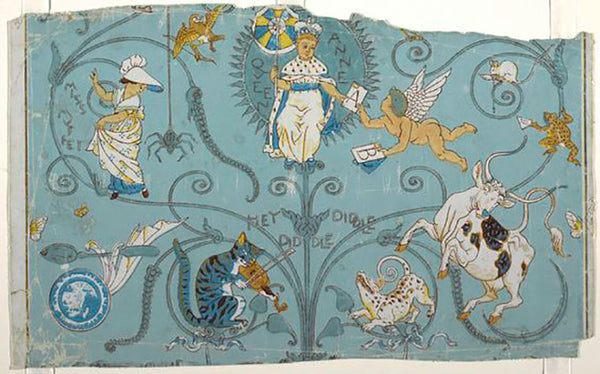
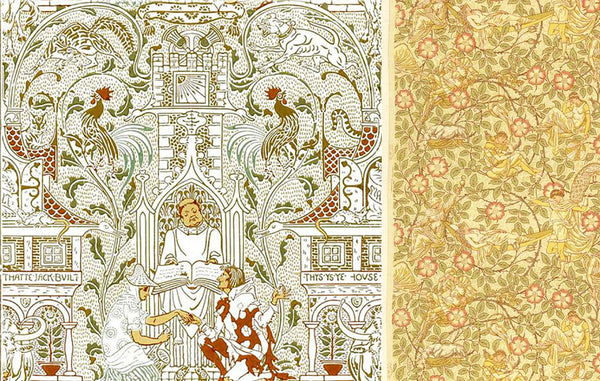
Walter Crane nursery wallpaper designs, clockwise from top, Nursery Rhymes (held at the Cooper Hewitt Collection), Sleeping Beauty, The House That Jack Built.
Charles F. A. Voysey was another designer who was very influential in wallpaper design at that time and he created some of the most wonderful papers for children. Cleverly, he combined intricate, imaginative themes with sophisticated repeating patterns, ensuring the designs looked harmonious once covering a whole wall. I believe this is one of the reasons for their enduring appeal, indeed numerous designs can be purchased today from Trustworth Studios, and House of Hackney re-issued the brilliant Alice in Wonderland paper in 2016.

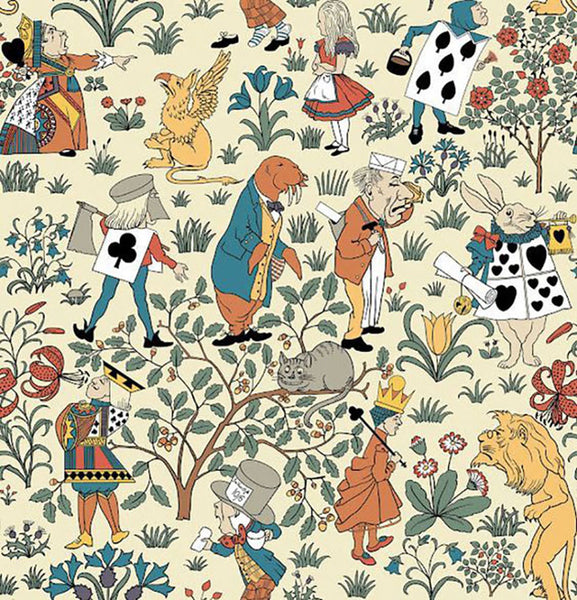
With the trend towards fun and playful nurseries came a raft of new papers in the early 20th century, with a whole host of themes and characters represented, from the genteel to the joyful.
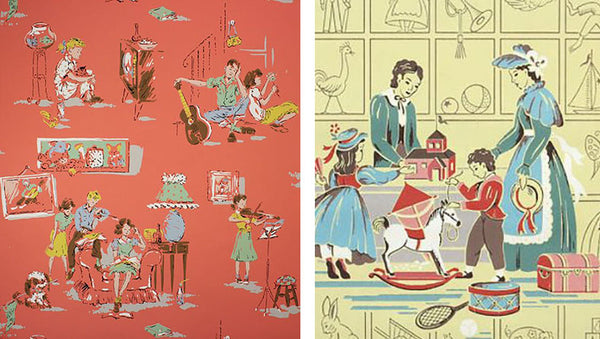
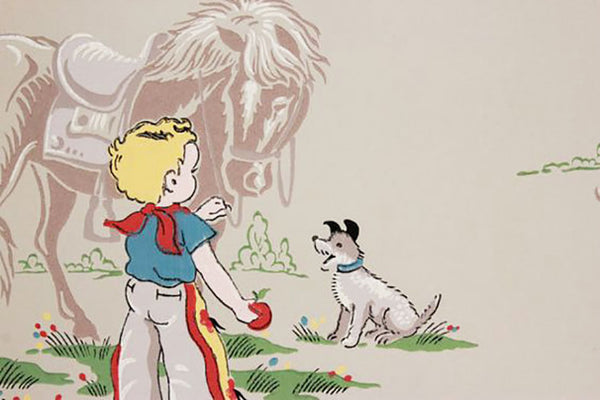
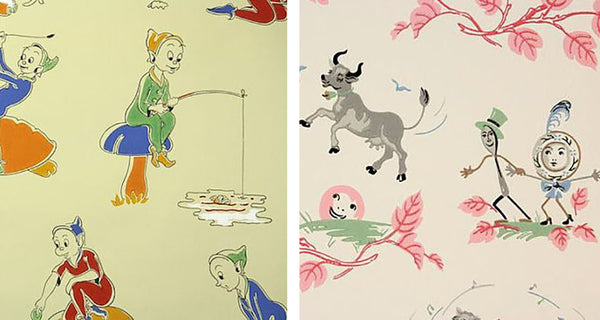
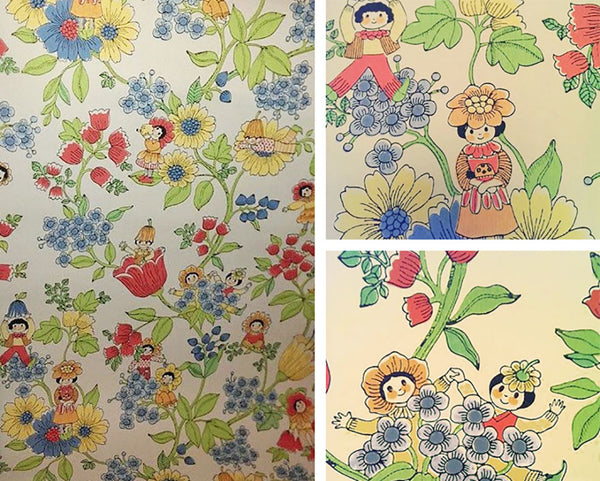
By the 1950s Disney got involved in wallpaper and the Peter Pan design below is one of my favourite vintage designs amongst those I have come across.

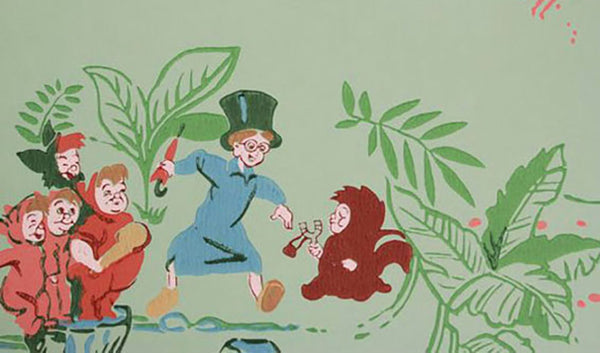
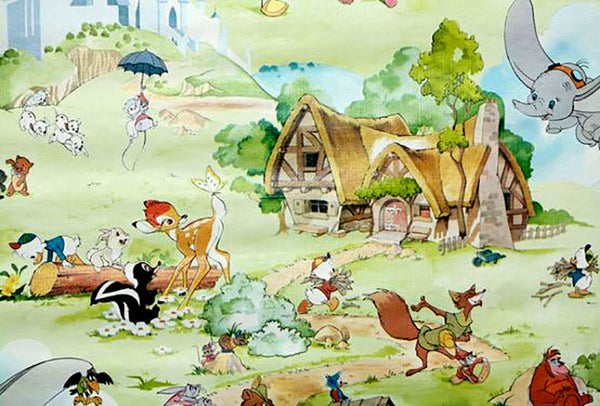
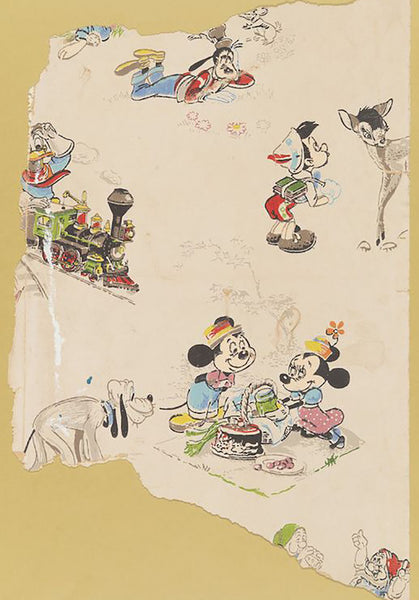
Inevitably, general trends in fashion, art and design impacted the designs of children's wallpapers and you can see so clearly the aesthetic trends of the time through them; bold colours and simplified shapes in the 1960s and early 1970s, and an array of colours and elaborate designs (and a little New Romantic flavour with the very popular Pierrot design - we had the duvet set!) in the late 1970s and 80s.
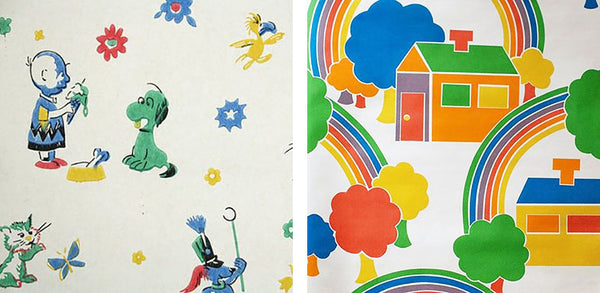

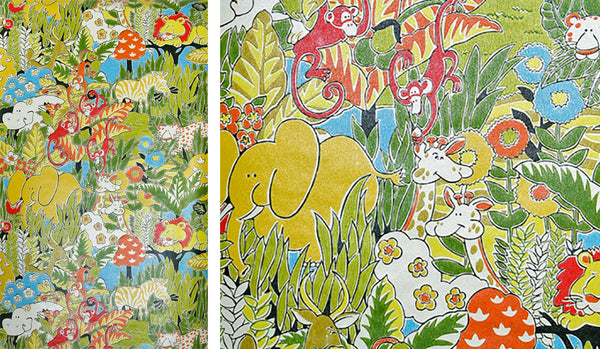

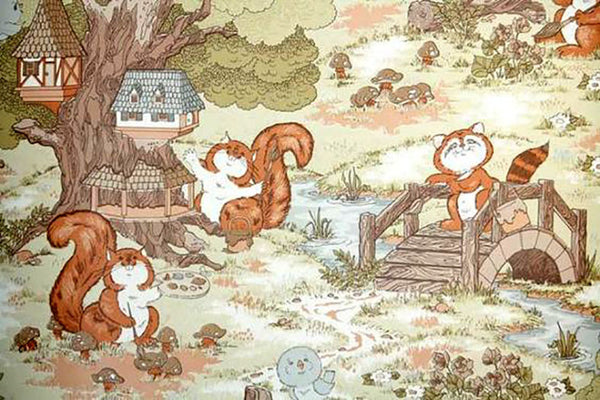
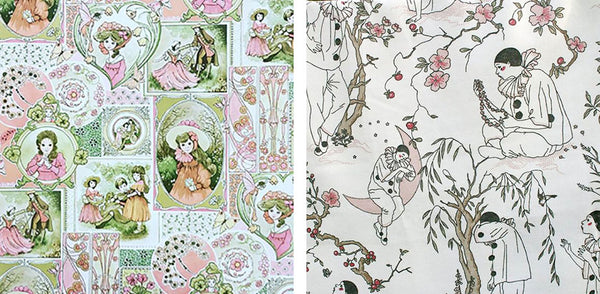
However, in the 1990s, with the advent of computer aided design and another aesthetic shift, this time away from the vibrant excesses of the 80s, wallpaper designs for children became much simpler and, in fact, paint was widely preferred. I noticed that a lot of papers from the 90s and early-to-mid 2000s employed simple repeats and often had little detail, perhaps due to the speed and ease of using a computer programme. Of course designs such as this have their place and can look great but it seemed a shame to me that there was a lack of imagination there. I believe that the detail and narrative quality of earlier designs is what made them so inspiring and memorable to children and that there is no reason why such magical designs can't be created now but with a contemporary aesthetic.
I'm happy to see that there is, again, a move towards imagination, storytelling and an appreciation of nature in design, which is being reflected in design for children, and hope that Renn Designs wallpaper contributes to creating magical, inspiring spaces for children to dream and play.
For an amazing selection of vintage wallpapers for sale see:
Hannah's Treasures
Rosie's Vintage Wallpaper
Artist, designer, writer and socialist, William Morris (1834 - 96) moved into the Red House in Bexleyheath - in the rural outskirts of London - with his wife in 1860 and spent the next two years furnishing and decorating it, assisted by a group of artist friends he met through Edward Burne-Jones. It was aquired by The National Trust just 10 years ago and is now open to the public - I went to visit a couple of weeks ago!
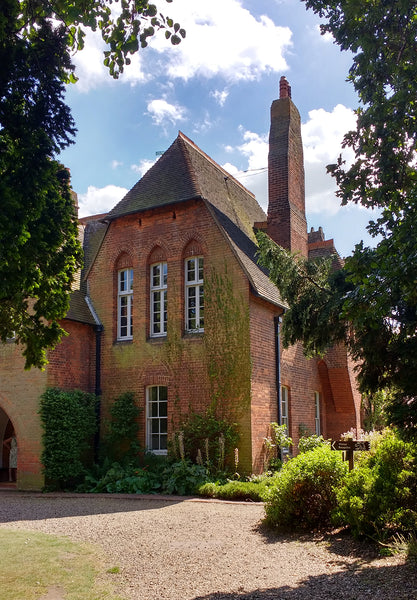
Upon marrying the popular artists' model, Jane Burden, Morris commissioned his friend, architect Philip Webb, to design this modern house. For the creation of their unique interior he took inspiration from medieval art and architecture, and a love of nature and stories, fostered during a childhood spent surrounded by the English countryside. Morris and his creative friends felt the finished result was such a success they started their own company, Morris, Marshall, Faulkner & Co.
I wrote about Morris as part of my undergraduate dissertation and discovered how fascinating and pioneering he was, both in the art world and the political sphere. He was the founder of the Arts and Crafts movement and designed textiles, furniture, wall-hangings, and wallpaper, while also writing essays and giving speeches concerning inequality between the classes. His belief in the life-enhancing potential of art and beauty has always stuck with me.

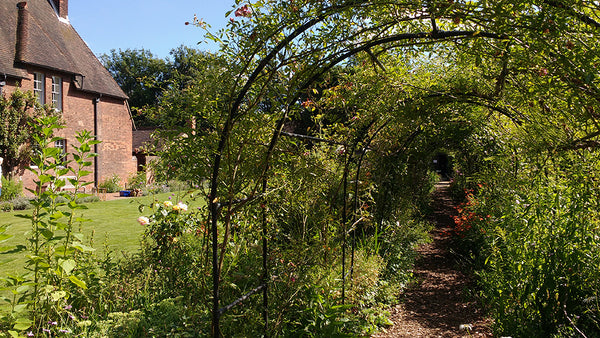
The house and gardens are beautiful, it was the perfect spot for a picnic!
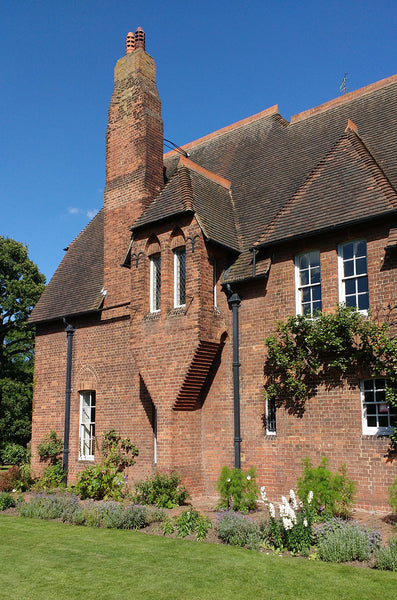
The window below was painted by Morris himself.
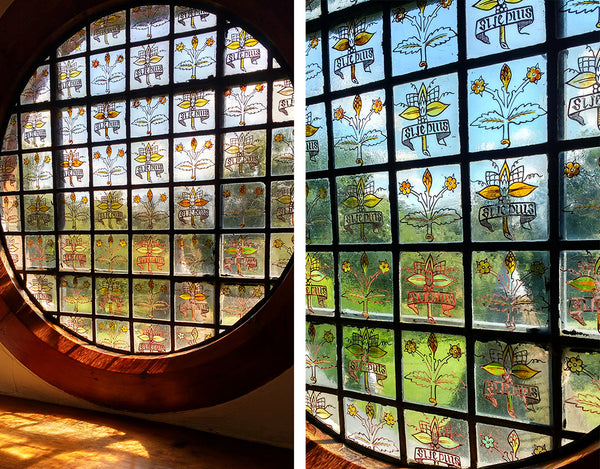
And the patterned ceilings looked strikingly modern.
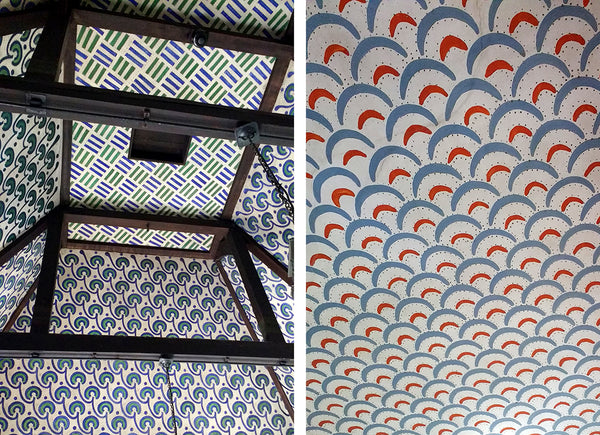
I particularly admired these painted tiles and am glad to see that hand-crafted tiles and ceramics seem to be enjoying something of a renaissance at the moment.

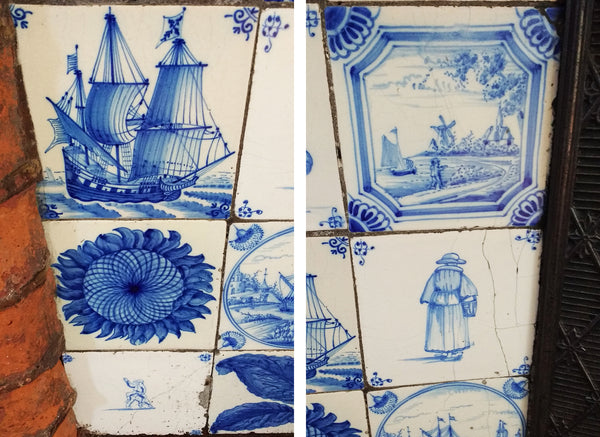
There are also books of Morris & Co. (as the company was later called when Morris assumed sole responsibility) designs for visitors to look at in one of the rooms. Below are: Strawberry Thief, an early textile design; Golden Lily, by J. H. Dearle and Fruit, one of Morris' earliest wallpaper designs, which I love!

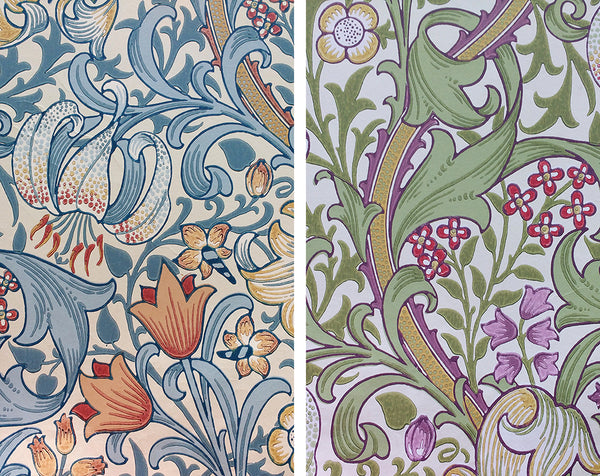

Wonderfully, Morris & Co. is still in business today, and you can read all about the history and the man himself, here.
Of the many aspects involved in designing wallpaper, one I find particularly satisfying is the creation of a pattern which, once repeated, becomes more than the sum of its parts; in the nature of the repeat you can create movement, dynamism, harmony and an immersive environment.
Since my first foray into pattern design as a freelance textile designer, I have come to notice patterns in my surroundings more than ever and of course nature, once again, provides the most beautiful, unusual and inspiring examples.

Plants feature in much of my work, providing a perfect excuse to visit my favourite place in London, Kew Gardens, in the name of research. Here I continually discover new species (new to me, anyway), their unique shapes and patterns never fail to inspire me. Even the seemingly simple leaf comes in such an array of forms, colours and arrangements, as my little leaf montage above and the gorgeous examples below demonstrate!

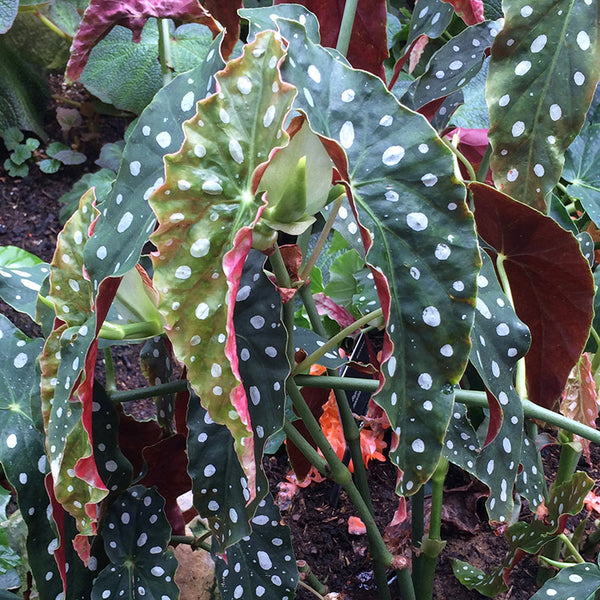
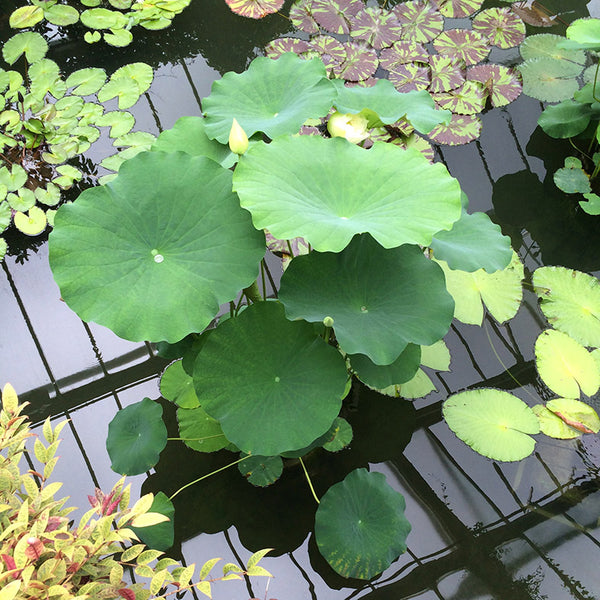
Cacti and succulents display a wealth of patterns and hues, something which has seen them widely represented in print design and illustration recently. It's easy to see how so many people have found inspiration in their weird and wonderful forms.
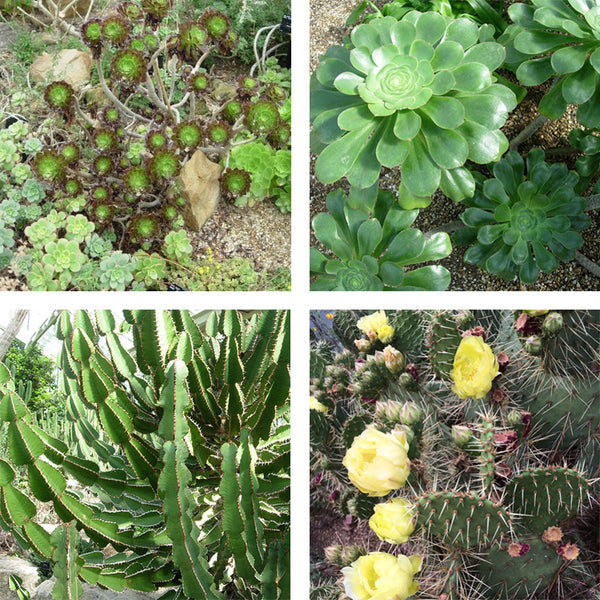
The greenhouses of Kew Gardens are home to thousands of tropical plants and trees, from the giant palms in the Victorian Palm House, to the tiny delicate orchids found in the Princess of Wales Conservatory, and all manner of marvelous species inbetween...offering endless opportunities for pattern discovery.
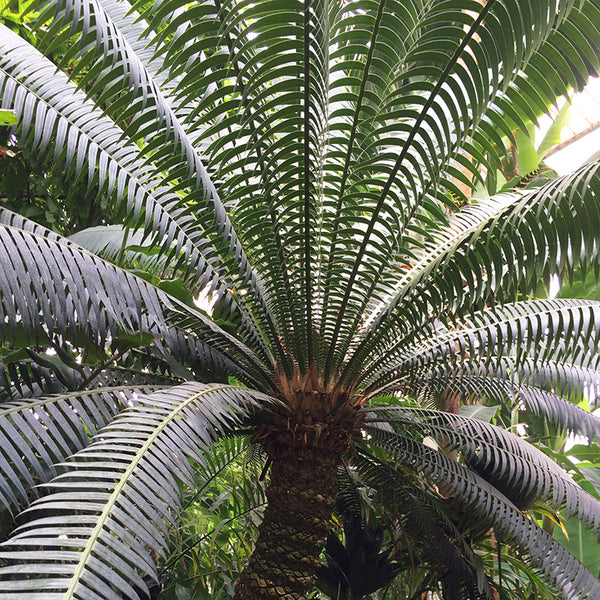
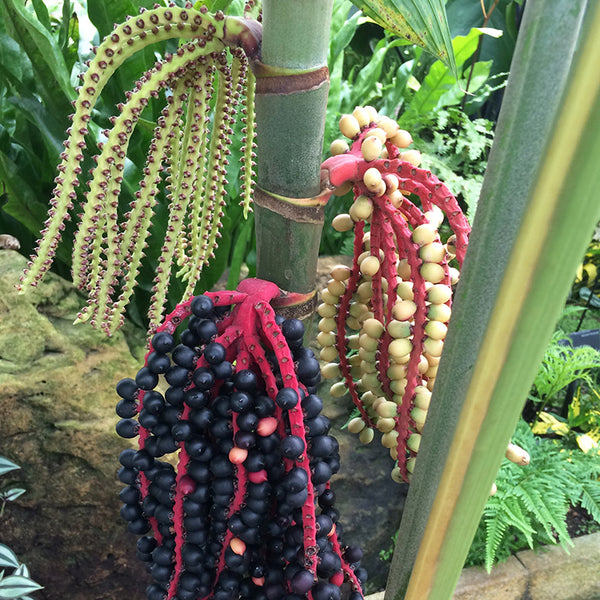


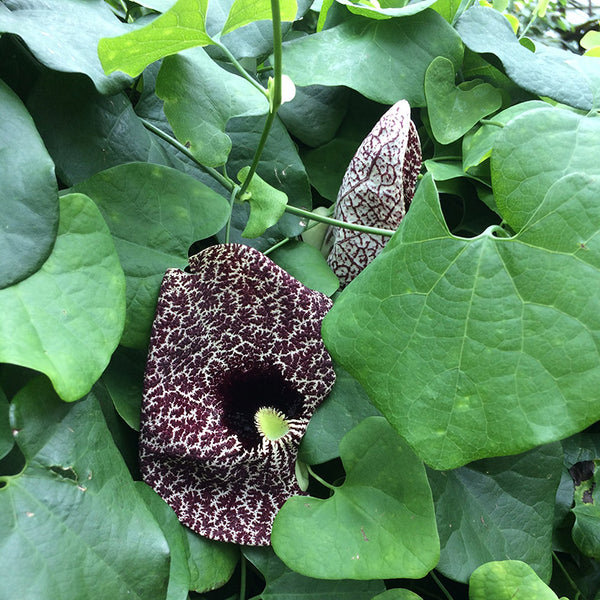

Coming up with a logo to represent your business can present a number of issues - do you try to convey what it is you do, or create? Do you choose something personal, or something that encapsulates your ethos? Fortunately, this task was made a lot easier for me owing to the fact that a Renn family logo already exists, although the family business is no more.

My paternal Grandad, Harold Arthur Renn, from Croydon in London, borrowed £100 from his mother-in-law (my Grandma, Irene's mother) to start his London-based business Renn's Shaped Ply, and used the image of the little Wren bird as his logo. I was lucky enough to find the above original 1949 advert online, from a vintage print shop, and bought it for £4 - not a bad price to pay for a bit of family history!
Before my grandad's business came to be, his father, a piano-maker, owned and ran Temple Pianos in Stoke Newington, Hackney, and during both World Wars his expertise in shaped wood was called upon to help develop wooden parts for fighter aircraft, using new plywood technology. His factory switched from making pianos to making propellors in WWI, and parts for the Mosquito aircraft in WWII - there was not such a call for new pianos during the wars anyhow! It was this new plywood technology - producing very light yet strong pieces - that led to Renn's Shaped Ply; furniture made in this way was an innovative product and the business grew quickly, with a factory just off Brick Lane in East London. Harold was able to pay back the £100 within a year.

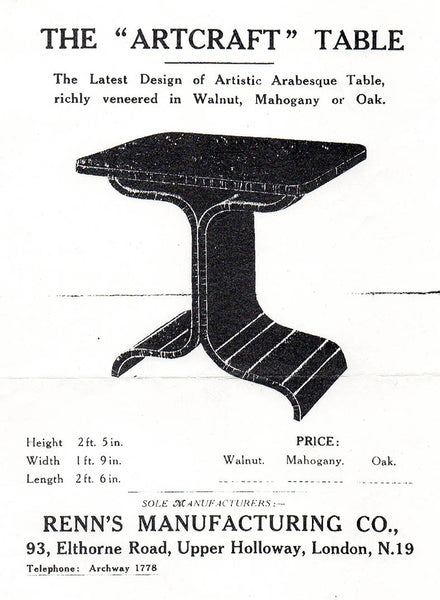
My Dad tells me that my Grandad was well liked as a boss, a sociable character, who happily employed people from all backgrounds, religions and ethnicities, at a time when this was often not the case. I found out recently that one of the Kray twins worked for him for a brief period, before they embarked on a life of crime...The factory experienced fluctuating fortunes over the years, like many businesses, and when the building itself was eventually condemned in the 1970s, Renn's Shaped Ply was sold.
My Grandad died two years before I was born, and so I have only known him through stories and photographs. It was a simple decision for me to use the little Wren bird for Renn Designs' logo, and the Renn family name, and I am happy that through this I can keep a little of the family history alive.

The RHS Chelsea Flower Show has been held in the grounds of the Royal Hospital Chelsea, London every year since 1913, with the exception of gaps during the two world wars, and it is a gardener's (or garden-lover's) Paradise.

Until last year I had never attended, and had a vague notion of it as an event with a lot of flowers, a lot of Pimms and a lot of people looking elegant. Wonderful as that sounds, it was so much more spectacular than I imagined, and as the show returns in a couple of weeks (I'm not going this year, sadly), I thought I'd share my highlights from last years visit. It was truly inspiring and I am sure some aspects of it will find their way into a design in the future, consciously or subconsciously.
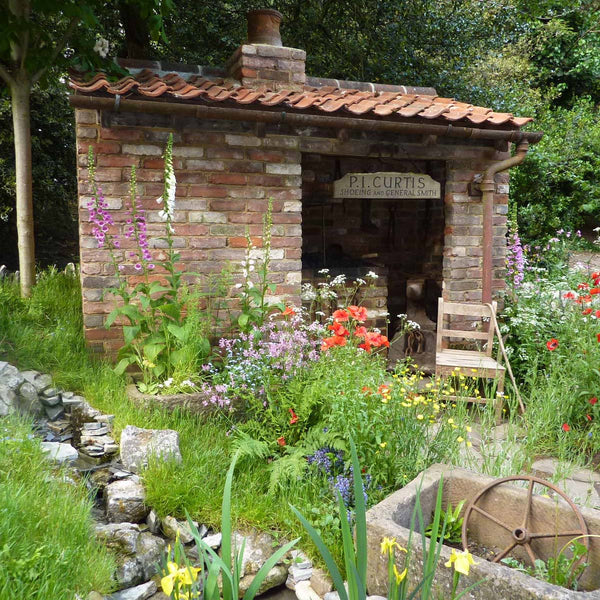

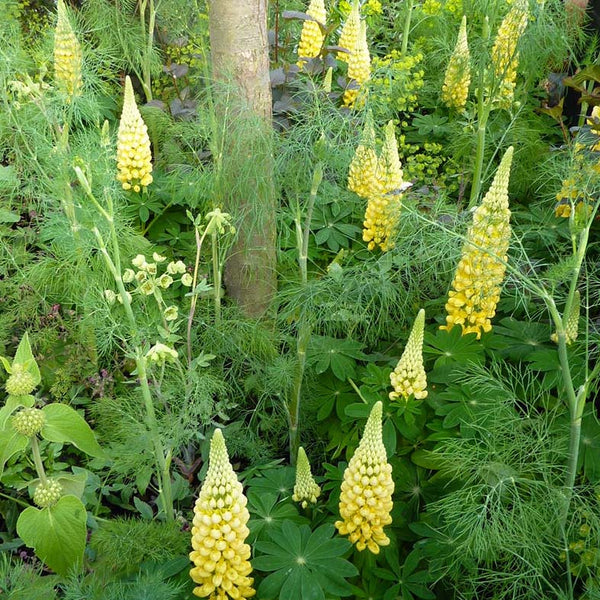
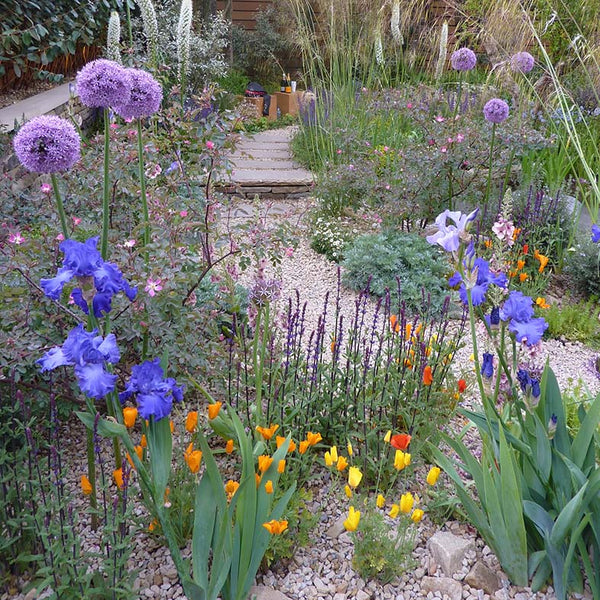
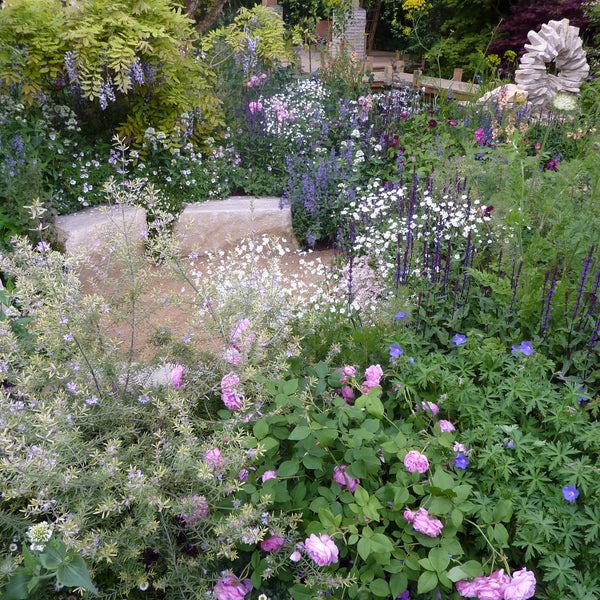


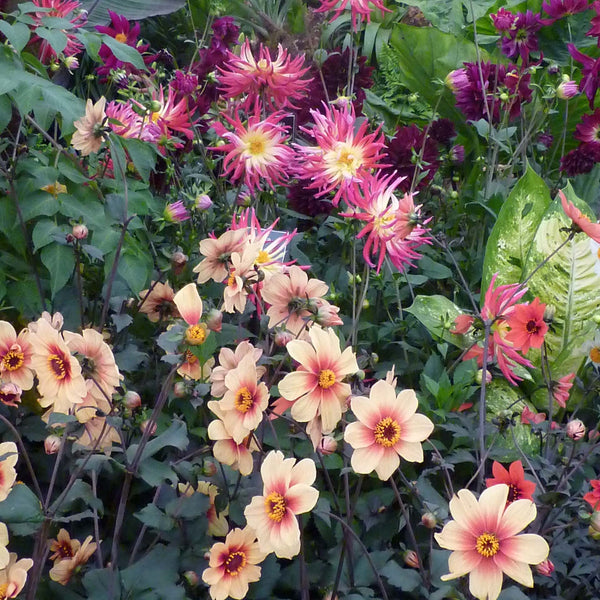
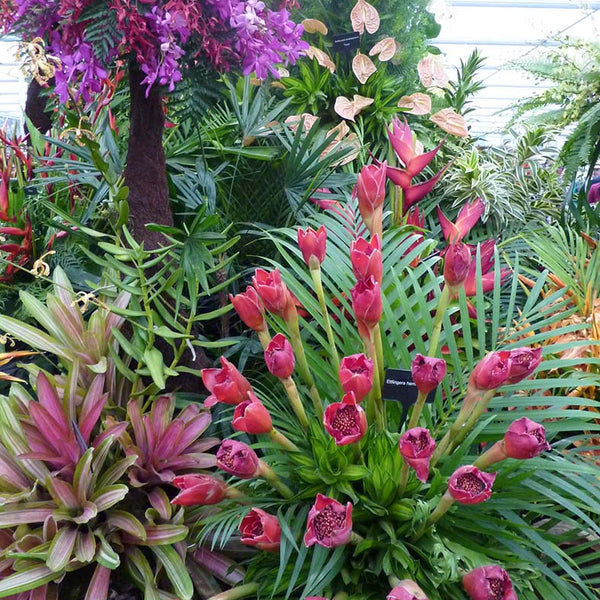
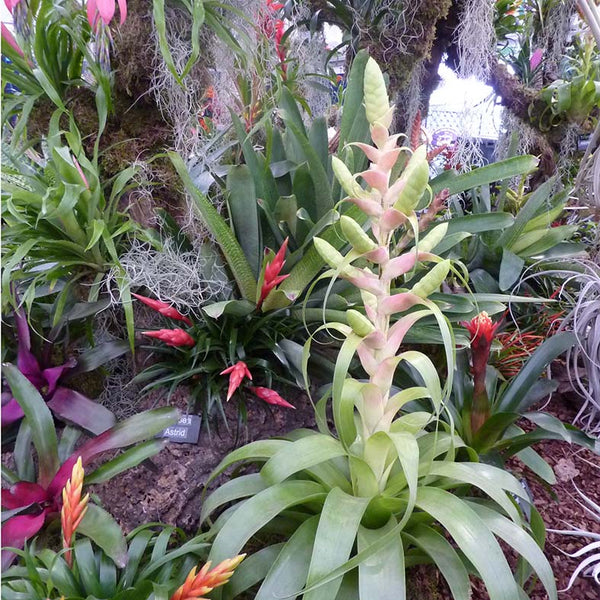
There were so many amazing displays on show that I couldn't pick a favourite, but these beautiful lupins below remind me of woodland-based stories from my childhood so I'm particularly certain they will feature in a children's wallpaper one day, which will hopefully also be remembered fondly long into the future.

So Rococo! Posted on 5 May 10:30
As a lover of colour and pattern I've been rather happy to see, and read, evidence that 'maximalism' is on the up - an inevitable reaction against the stark 'less-is-more' philosophy of minimalism. While I can appreciate clean lines and calm spaces, I just enjoy decoration too much to ever fully subscribe to the minimalist aesthetic, not to mention the fact wallpaper doesn't really have a place in minimal interiors! (There's a really fun piece '10 Signs You Might be a Maximalist' on the Apartment Therapy site here ).
With this in mind, it seemed a perfect time to feature Rococo, an eighteenth century art movement, on my blog and the beautiful examples on show at the Wallace Collection in London. I've been there so many times (it's free!) and it never fails to inspire me.

The magnificent furniture, paintings and artefacts were collected between the late eighteenth and nineteenth centuries, by the first four Marquesses of Hertford and Sir Richard Wallace, son of the fourth Marquess. Lady Wallace, following her late husband's wishes, bequeathed the collection to the nation on her death.
Rococo itself originated in seventeenth century France, with the rise of the middle classes, who increasingly spent their growing wealth on interior decoration. It saw the rejection of a formal, serious style which had pervaded the arts, and their persistently religious and political themes, in favour of something more playful, graceful and frivolous. Natural forms were used abundantly and the term Rococo is thought to derive from the French rocaille, meaning pebble, and refer to the stylized shell and rock-like motifs. A classic example of this new jovial style is the painting by Jean-Honoré Fragonard, The Swing (1767, below), probably the Wallace Collection's most famous.

Incidently, if you've seen the Disney film Tangled, there is a scene inspired by this painting!
It is probably the colour and fun of Rococo that appeal to me most, yet for all its light-heartedness an emphasis was also placed on elegance, which stopped it straying into gaudiness - though some people would probably disagree! It ought to be said that it is a somewhat superficial style, often associated with the excesses of the court of King Louis XVI, but it did produce some beautiful art...
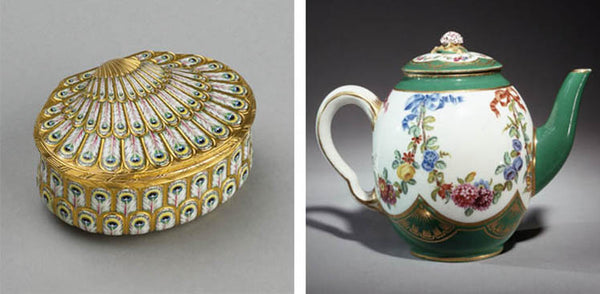

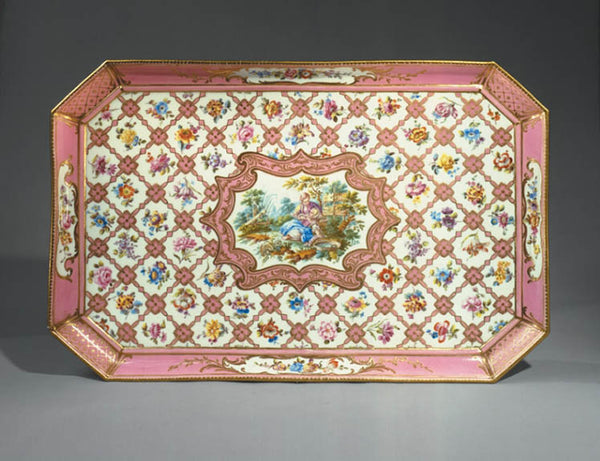
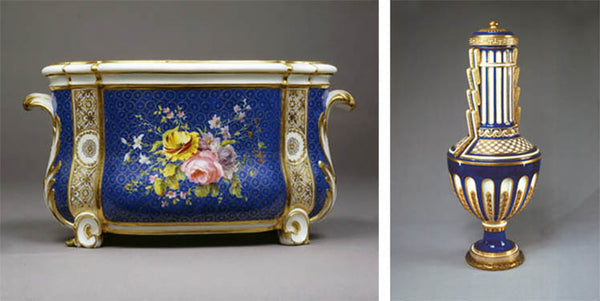
Rococo's greatest influence was in interior design and decoration, there are fewer examples of Rococo architecture but one in particular stands out; Catherine Palace in Tsarskoye Selo, the Summer residence of the Russian Tsars. Completed in 1756 it is almost 1km in circumference and over 100kg of gold was used on the gilt facade!
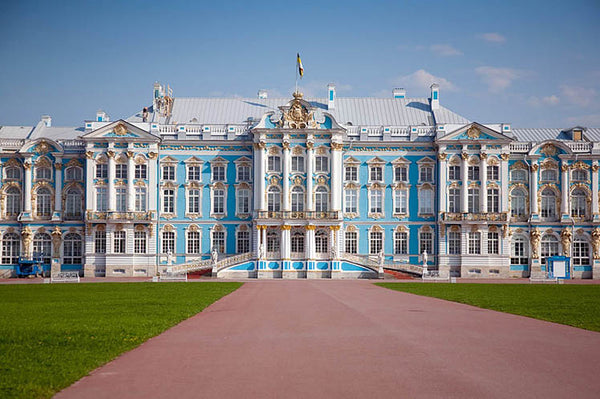
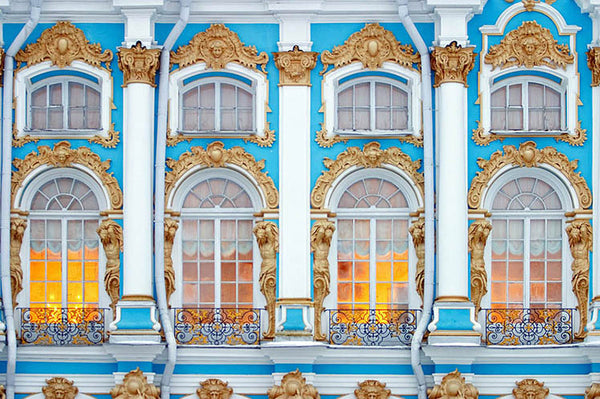
Naturally, Rococo influenced the fashions of the time, as demonstrated in this fabulous book, Costume Cavalcade, by the then head of costumes at the Danish National Museum, Henny Harald Hansen (first published in 1954, my sister bought it in a charity shop). She summarises:
No costume could be more flattering than that worn in the century when men compiled encylopaedias and women presided over salons, and when Rousseau preached his gospel of the return to nature. Their clothes transformed them into exquisite works of art and conformed perfectly to the spirit of an age which raised its monuments in porcelain and painted its portraits in the coloured dust of the pastel.
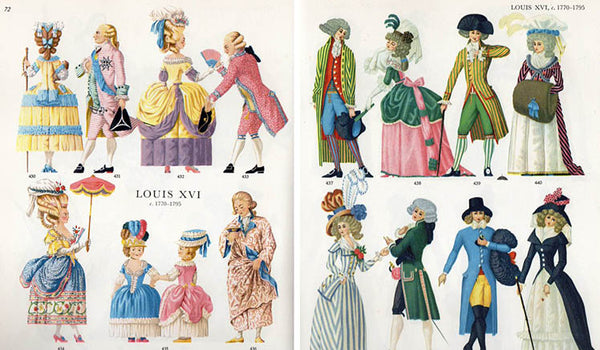
Perhaps in another life I could have excelled at presiding over a salon, dressed like confectionary!
It's always brilliant to go somewhere completely new for inspiration, and Marrakech, unsurprisingly, was such a treat. From the glorious beauty of Marjorelle Gardens to the vast warren of traders in the colourful souks, there is so much for a designer to absorb in this ancient city.

Pattern and decoration is hugely symbolic in Islamic culture, and when Muslims came to Morocco from the Middle East in the seventh century they brought with them a tradition of decorative art and design. Because animals and humans cannot be depicted in Islamic art, the complex geometrical designs we associate with Morocco developed; blues and greens were used in abundance to represent and celebrate nature. North African Muslims also ruled much of Southern Spain - the area we know now as Andalucia - and skilled tile workers from this region came to Marrakech to decorate palaces and royal tombs, creating the distinctive Moorish (Arab/Spanish) architectural style which is also abundant in the Andalucian capital, Seville.
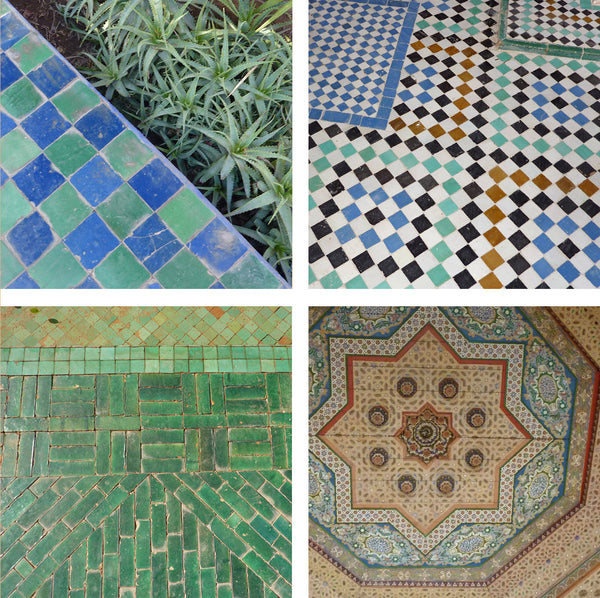
The original inhabitants of Morocco were Berbers, and Marrakech is home to the largest number of Berber markets - the souks - comprising tens of thousands of stalls in total - I think our tour guide mentioned it was as many as forty thousand! Many of the stalls sell traditional Berber craft items, from colourful leather slippers to intricately patterned metal lanterns. Our wonderful three-hour guided tour of the main sites of Marrakech took us into the heart of the souks; it really is something to behold - the sheer scale and variety, the colour, the smells, the crafts-people, right there, welding lanterns behind a tiny alley...As you can imagine it's pretty hectic and very easy to get lost, which made being guided through it a great way to take everything in without constantly wondering where you are, or how you'll ever get out!
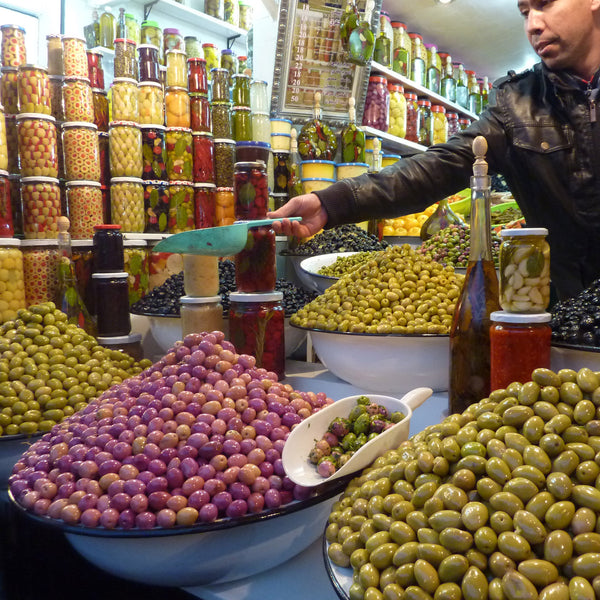
As a garden lover, one of my favourite places in Marrakech was the beautiful Jardin Marjorelle, created by French Painter Jaques Marjorelle (the dazzling shade of blue used extensively in the garden is named after him, Marjorelle Blue) and later bought and restored by Yves Saint-Laurent and Pierre Bergé. A daring combination of bright blue and yellow works so well in this exotic garden, full of cacti and palm trees. I have been inspired to be more daring with my own colours - expect more bold palettes from Renn Designs!

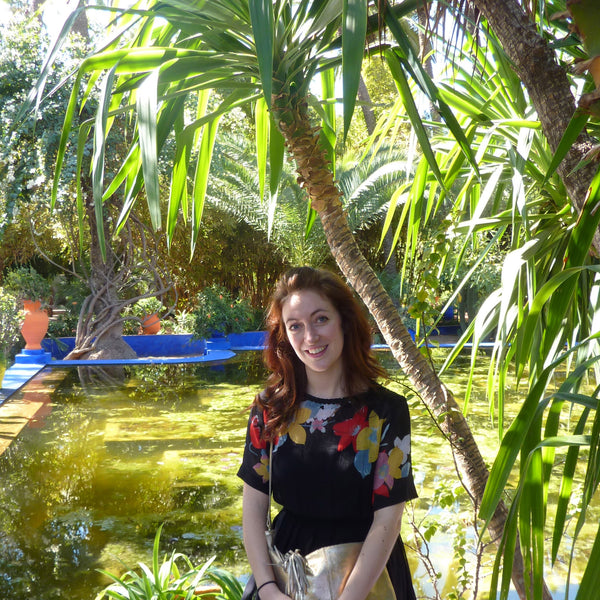


As a London city dweller, used to a fairly cool (ie dismal!) climate, it was so nice to be amongst the palm trees, cacti and borgainvillea which grow abundently in Morocco. I'd never been to a place where borgainvillea thrives so much and was particularly taken by the way it contrasts magnificently with the geometrical architecture and provides huge bursts of colour.
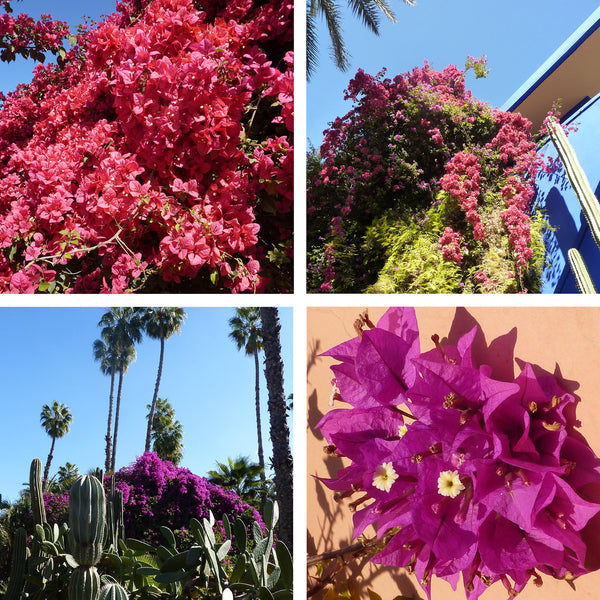
My favourite borgainvillea image of the trip is this one, below, of my beautiful friend Natalie appreciating it in the Moroccan sunshine.
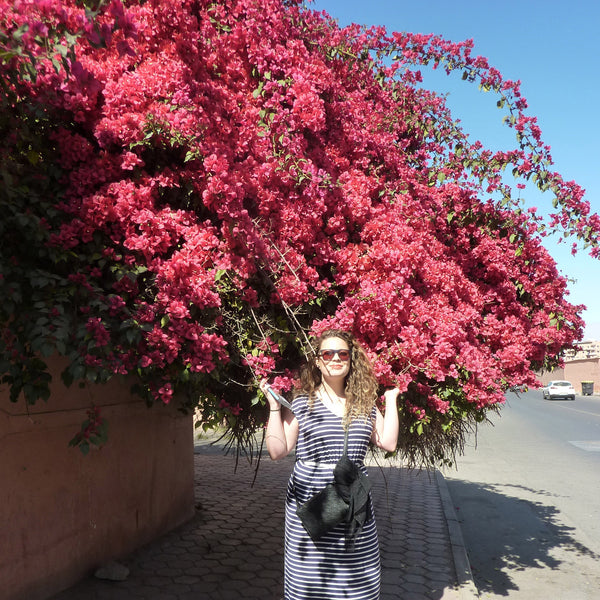
I couldn't talk about Morocco without mentioning the food and the people. We met some really warm, welcoming and interesting locals on our trip, from a flamboyant and knowledgeable purveyor of argan oil - with a penchant for breaking into song - to the young food stall-holders who served us an array of authentic Moroccan dishes in the main square, on my birthday. Here we are shortly after having been sung Happy Birthday in Arabic and given a rose each - the charmers!
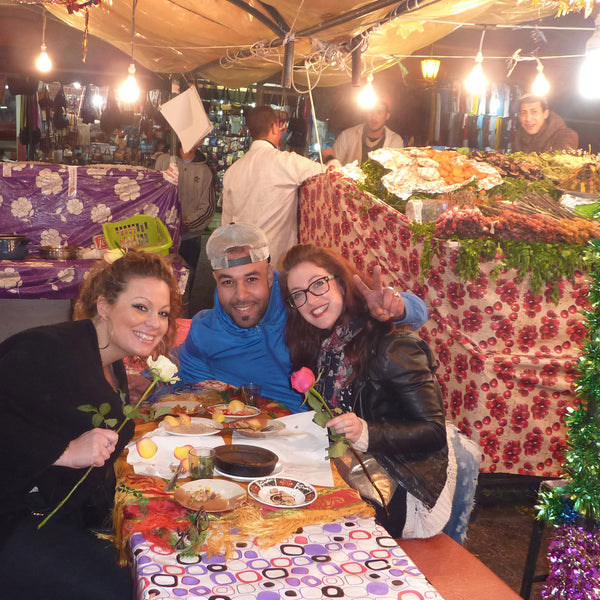
'I perhaps owe having become a painter to flowers'. Claude Monet, 1927.
Monet's enduring popularity means we're so used to seeing his paintings, particularly the water-lilies, reproduced on all manner of items, that it's easy to overlook just how magnificent they are in reality. This exhibition is simply stunning, and there is still time to go and see it! (It's on at the Royal Academy, London, until April 20th). While the primary focus is Monet, who's absolute love of nature is beautifully demonstrated and discussed, it's a very large exhibition with so many extraordinary paintings by numerous artists, including Cézanne, Klimt and Matisse.
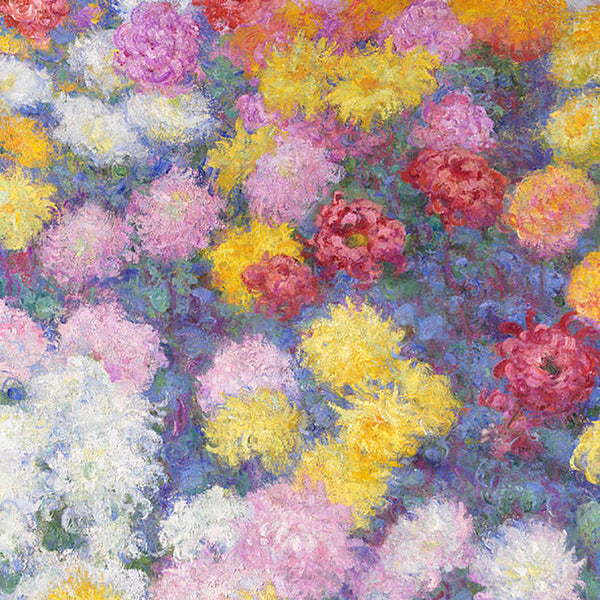
Claude Monet, Crysanthemums (crop), 1897
The above painting is one of my favourite examples of Monet's exquisite use of colour; if you imagine it without just one of any of his chosen hues it wouldn't be nearly as effective. The exhibition explains that he took inspiration for these extreme close-ups from Japanese paintings and prints, citing Katsushika Hokusai (below Flowers, Peonies and Butterfiles, 1830s), as an example. These close-ups paved the way for his Grandes Décorations of later years; huge paintings of his water-lily garden in which the interplay between light, colour and atmosphere are of much greater importance than depiction of the forms.
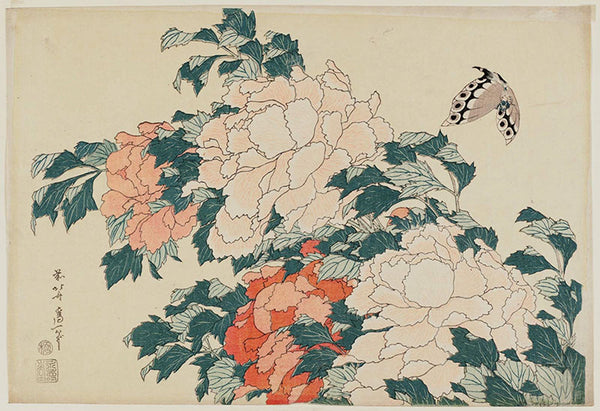
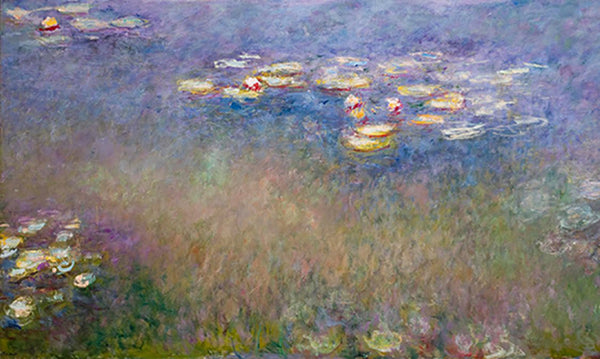
Claude Monet, Water Lilies, 1916-1926
These paintings took the impressionists' 'art based on sensation' (a phrase coined by Camille Pissarro) to a new level, and there is something deeply peaceful and contemplative about experiencing them in all their expansive glory - it is the first time that the three enormous Water Lilies, painted as a triptych between 1915 and 1926, have been exhibited together in Europe. I later discovered that Monet's Water Lilies series included 250 paintings, such was his affinity with this part of his garden; he did claim that the garden at Giverny was 'my most beautiful work of art', after all.

Claude Monet, Water Lilies, 1914-1915
The exhibition also provides a really interesting background to how gardening became the favoured pass-time we know it as today, something I had never considered, due to the 'Great Horticultural Movement', which coincided with the growth of the middle classes and advances in science and technology. In 1898, the President of the Society of American Florists is quoted as saying:
Show me one who cultivates flowers...and I will show you a home in which love prevails...
It was also at this time that gardens as public attractions became fashionable, a legacy to the Movement I am personally very happy about! I've since read more about the garden at Giverny as it is today and it's firmly on my must-visit list now. The intention of the gardeners there is to engender in the visitor the same emotions they might feel on viewing a Monet painting, by planting to maximise the impact of light, colour and atmosphere - it sounds wonderful.

Santiago Rusiñol, Hydrangeas on a Garden Path, 1929
It's always lovely to discover new artists at an exhibition and Santiago Rusiñol is one I was previously not aware of but his work stood out, for me personally. The way he captures sunlight in his garden paintings evokes how it feels to be outdoors, surrounded by nature, on a perfect sunny morning or evening, when the light makes everything look a little magical; something I really relate to as that is how I would spend much of my time if I could!

Santiago Rusiñol, Green Wall, Sa Coma, 1904
Painting The Modern Garden takes artists' fascination with gardens through to the early days of Modernism and the avante-garde with works from Matisse, Macke, Dufy and Kandinsky, amongst others. Here are the beginnings of abstraction, and there are some striking examples from artists often better know for different subjects and styles.

August Macke, Garden Path, 1912 and Henri Matisse, Acunthus (Moroccan Landscape), 1912
I can't recommend this exhibition enough, it's a beautiful reminder to take the time to appreciate the spectacle of the natural world and, thereby, allow ourselves to be moved by it, as the artists exhibited so clearly were.
I was happy to see one of my own little fascinations as an illustrator - deckchairs (it's something about the shape and the association with relaxation) - included in a painting by P.S. Krøyer, and I'm looking forward to embracing the modern garden in my own way as the years go by.

P.S. Krøyer, Roses (Marie Krøyer Seated in a Deckchair in the Garden by Mrs Brenden's House), 1893
For as long as I can remember, my imagination has been totally captured by nature and the countryside, (despite never actually living in it) and it will always have a huge influence on my work.

As a child I loved looking at nature books before I was able to read them, going to the garden centre was a fun day out, and I would spend hours collecting shells on trips to the French Coast (my mum is French). I kept tiny snails temporarily as pets in an elaborate home I had constructed for them, and remember aged 11 or 12 walking home from school and buying myself a hyacinth plant from the local greengrocers; they are still one of my favourites but looking back, I don't think many children my age saw fit to spend their pocket money on perennial plants.
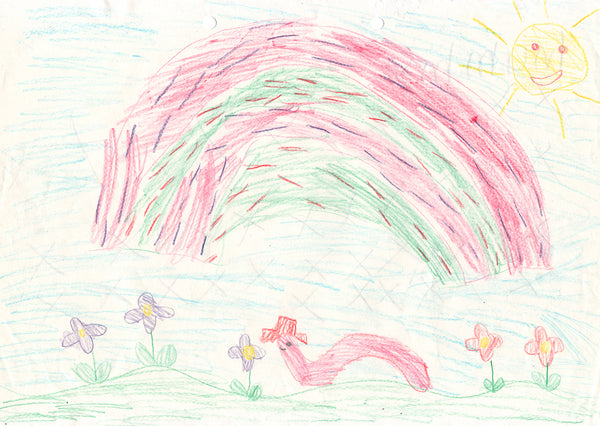
Picture books which depicted the countryside were also a constant source of wonder for me, and before I had really experienced much of it myself they provided endless inspiration for my childhood drawings - I spent A LOT of time drawing. Even an illustrated puzzle we had, of some mice playing in the garden of a thatched cottage, played a role in my decision that when I grew up I wanted to live in cottage with roses growing up the walls (this hasn't quite happened, maybe one day!) and many of my drawings consisted of cosy, country scenes. I pretty much wanted to live in Brambley Hedge or by The Riverbank with Ratty and Mole!
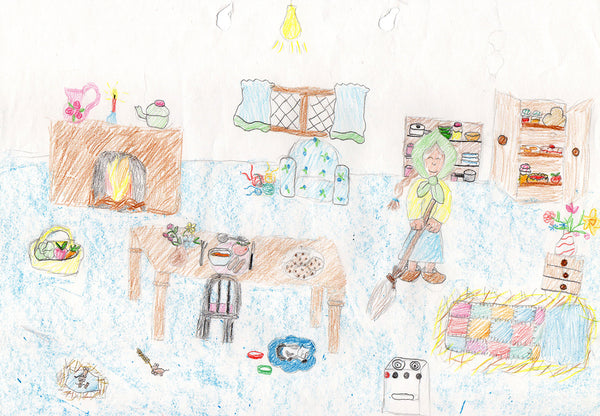
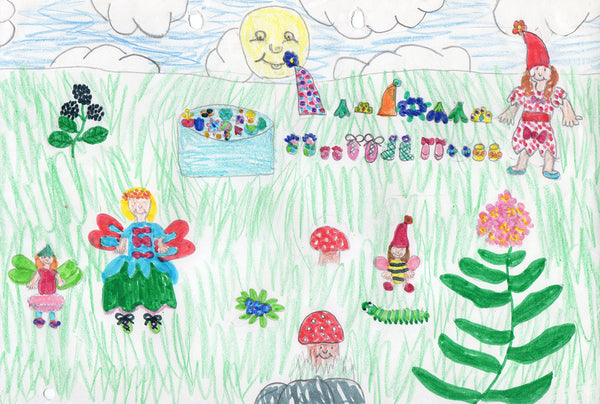
Below are illustrations from some of my favourite picture books set in the countryside. (The Lovely Present, Maurice Sendak; Wind in the Willows, Kenneth Graham, illustrated by Inga Moore; The Four Seasons of Brambly Hedge, Jill Barklem).
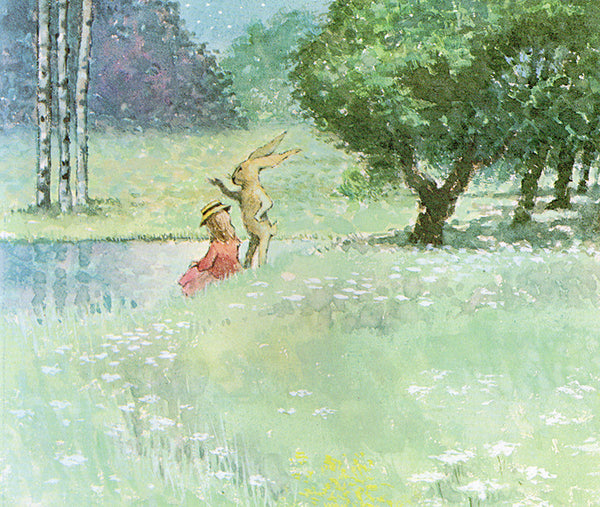
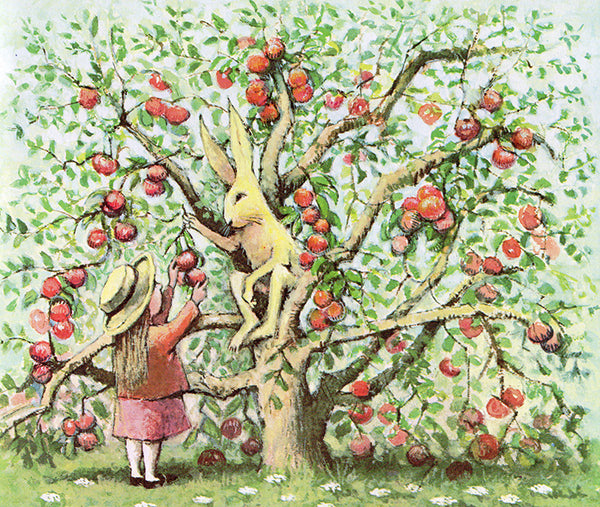

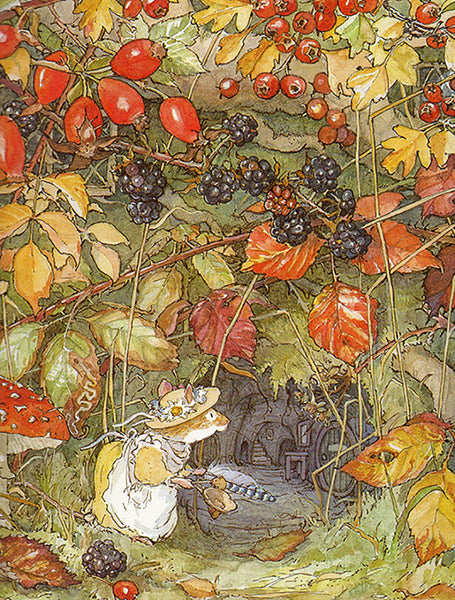
Naturally, my love of nature regularly surfaces in my work. Peonies were my favourite garden flower as a child so I happily included them in my Thumbelina - a fairytale by Hans Christian Andersen - inspired children's wallpaper, along with fritillaries (and more) which featured in a botanical colouring book I was given, many years before I saw some in reality at a Royal Horticultural Society show. Renn Designs Big Cats wallpaper is full of tropical plants I have seen on my many visits to the wonderful Kew Gardens.
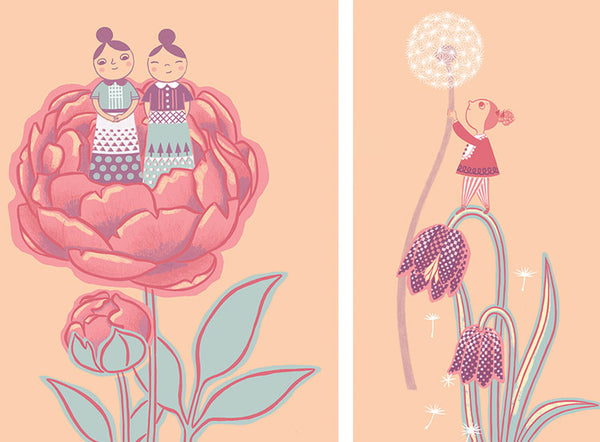

While working in a book shop a few years ago, I bought a battered book in the sale for 99p called The Sky and the amazing Northern Lights photographs inspired me to create my Northern Lights children's wallpaper, in which I wanted to capture some of the beauty and magic of nature and Space.

A happy customer and lovely friend sent me this wonderful photo of her son appreciating his Northern Lights wallpaper in his bedroom. She said he notices something new every day and I very much hope his young imagination has been captured by my design, in the way that mine was, and still is, by nature and beautiful depictions of it.
